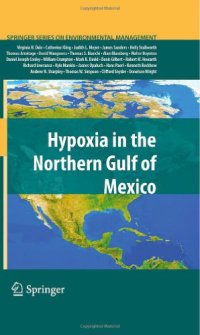
Ebook: Hypoxia in the Northern Gulf of Mexico
- Genre: Biology // Ecology
- Tags: Environmental Management, Freshwater & Marine Ecology, Environmental Monitoring/Analysis, Waste Water Technology / Water Pollution Control / Water Management / Aquatic Pollution, Environment general, Environmental Law/Policy/Ecojust
- Series: Springer Series on Environmental Management
- Year: 2010
- Publisher: Springer-Verlag New York
- Edition: 1
- Language: English
- pdf
Hypoxia in the Northern Gulf of Mexico is based on an extensive review conducted by the Hypoxia Advisory Panel of the Science Advisory Board for the Environmental Protection Agency, which was chaired by the editor. The book examines scientific advances that, since 2000, have increased understanding of hypoxia in the Gulf. It discusses characterization of its cause, characterization of its nutrient fate, transport, and sources, and the scientific basis for goals and management options. Using available data, including models, model results, and uncertainty, the advisory team addresses the strengths and limitations of managing the Gulf hypoxia problem. This book will be of interest to specialists in the fields of environmental sciences, social sciences, economics, landscape architecture, planning, and communication of risks.
Virginia Dale is a Corporate Fellow in the Environmental Sciences Division at Oak Ridge National Laboratory. She is also an adjunct faculty member in the Department of Ecology and Evolutionary Biology at the University of Tennessee.
The goal of the book is to examine scientific advances since 2000 that may have increased understanding and options in three general areas related to hypoxia: Characterization the Cause(s) of Hypoxia. The physical, biological and chemical processes that affect the development, persistence and extent of hypoxia in the northern Gulf of Mexico. Characterization of Nutrient Fate, Transport and Sources. Nutrient loadings, fate, transport and sources in the Mississippi River that impact Gulf Hypoxia. Scientific Basis for Goals and Management Options. The scientific basis for, and recommended revisions to, the goals proposed in the Action Plan; and the scientific basis for the efficacy of recommended management actions to reduce nutrient flux from point and nonpoint sources. In addressing the state of the science, the book focuses on the strengths and limitations of the science in managing the Gulf hypoxia problem, including available data, models and model results and uncertainty. It includes work from the following authors: C. Kling, Iowa State University, Ames, IA, USA; J.L. Meyer, University of Georgia, Athens, GA, USA; J. Sanders, Skidaway Institute of Oceanography, Savannah, GA, USA; H. Stallworth, Environmental Protection Agency, Washington D.C., USA; T. Armitage, Environmental Protection Agency,Washington, D.C., USA; D. Wangsness, U.S. Geological Survey, Atlanta, GA, USA; T.S. Bianchi, Texas A&M University, College Station, TX, USA; A. Blumberg, Stevens Institute of Technology, Hoboken, NJ, USA; W. Boynton, University of Maryland, MD, USA; D.J. Conley, Lund University, Lund, Sweden; W. Crumpton, Iowa State University, Ames, IA, USA; M.B. David, University of Illinois, Urbana, IL, USA; D. Gilbert, Maurice-Lamontagne Institute, Mont-Joli, Quebec, Canada; R.W. Howarth, Cornell University, Ithaca, NY, USA; R. Lowrance, Agricultural Research Service, USDA, Tifton, GA, USA; K. Mankin, Kansas State University, Manhattan, KS, USA; J. Opaluch, University of Rhode Island, Kingston, RI, USA; H. Paerl, University of North Carolina, Chapel Hill, Morehead City, NC, USA; K. Reckhow, Duke University, Durham, NC, USA; A.N. Sharpley, University of Arkansas, Fayetteville, AR, USA; T.W. Simpson, University of Maryland, College Park, MD, USA; C. Snyder, International Plant Nutrition Institute,USA; Conway, AR; D. Wright, College of William and Mary, Gloucester Point, VA, USA.